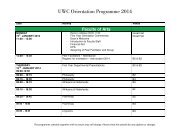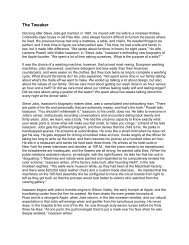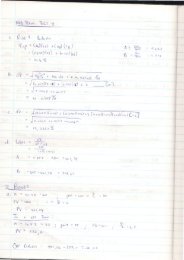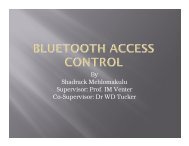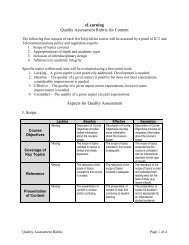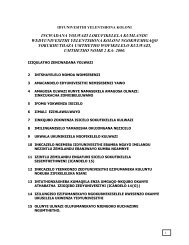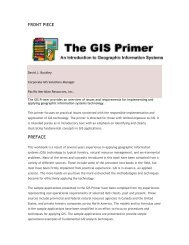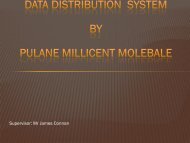Ecosystem Guidelines for Environmental Assessment
Ecosystem Guidelines for Environmental Assessment
Ecosystem Guidelines for Environmental Assessment
You also want an ePaper? Increase the reach of your titles
YUMPU automatically turns print PDFs into web optimized ePapers that Google loves.
FRESHWATER<br />
Introduction to the system of:<br />
- terrestrial alien and invasive vegetation<br />
- aquatic alien vegetation<br />
- alien fish and other animals<br />
Pollution sources affecting water quality - point and non-point sources.<br />
Pollution sources affecting water quantity (e.g. stormwater runoff; discharge from waste water<br />
treatment works).<br />
Inter-basin transfers.<br />
Emphasis on development that compromise long-term ecosystem functioning.<br />
What are the “bottom lines” and non-negotiables<br />
A flow regime that is adequate to maintain the river at a desired and attainable Management Class.<br />
Water quality that is adequate to maintain the river at a desired and attainable Management Class.<br />
Buffers that:<br />
- are adequate to protect from the threats identified below, as relevant to each system,<br />
- allow <strong>for</strong> future rehabilitation, and<br />
- protect the habitat integrity of the receiving watercourse.<br />
Maintenance of existing ecosystem linkages/connectivity at an appropriate scale.<br />
No new concrete canalisation or piping of river channels.<br />
What broad spatial guidelines can be given with respect to<br />
the best approach to development and disturbance<br />
Allow adequate buffering of rivers and drainage lines. Ideally, buffer areas should first make allowance<br />
<strong>for</strong> future rehabilitation of the channel e.g. regrading and reshaping of hardened river banks - and then<br />
impose development setbacks from the theoretical edge of the rehabilitated river bank. The City of Cape<br />
Town's Floodplain Management <strong>Guidelines</strong> 1 should be used as broad guidelines <strong>for</strong> minimum setback<br />
areas. Additional evaluation of specific functional requirements of the buffer areas, on a site-specific<br />
basis (e.g. providing an appropriate buffer width <strong>for</strong> a system receiving treated effluent runoff, versus<br />
providing an adequate buffer against noise pollution or alien invasion).<br />
Spatial depiction of existing or past linkages between wetlands, drainage channels and rivers/streams<br />
should be provided, including groundwater in<strong>for</strong>mation where applicable; these linkages should be<br />
maintained where possible, and restored where feasible and ecologically desirable.<br />
What are the critical things to maintain in terms of managing these<br />
systems <strong>for</strong> biodiversity, and ensuring its persistence<br />
Flow regime, including seasonality, water quantity and links to the water table and groundwater system.<br />
Water quality.<br />
Bank slope and stability.<br />
Maintenance of natural erosion and sedimentation processes.<br />
Plant community structure and zonation.<br />
Habitat availability and accessibility.<br />
Instream biotope quality and availability.<br />
Control over invasion by opportunistic weeds and other invasive plant species.<br />
Control over invasion by introduced exotic fish and other alien fauna.<br />
76 : FRESHWATER ECOSYSTEMS - RIVERS 1. City of Cape Town (November 2000) Development Control <strong>Guidelines</strong> <strong>for</strong> Flood-prone<br />
Areas – Draft edition. CCT Catchment, Stormwater and River Management, Catchment<br />
Management Department, Cape Town.



